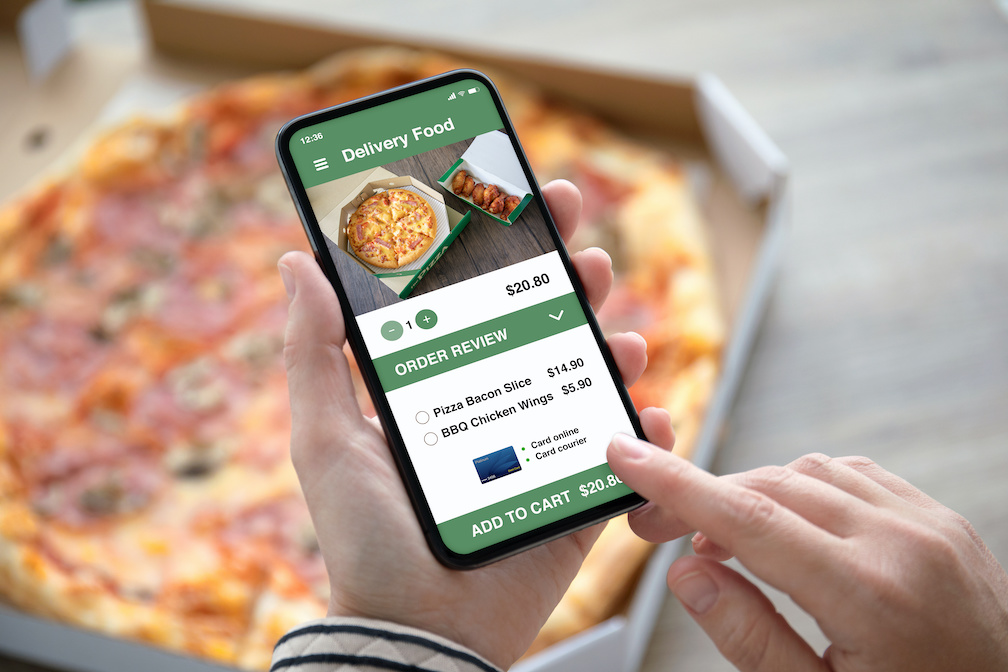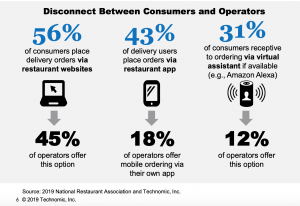Call Sales: +1 (833) 437-3835
Call Sales: +1 (833) 437-3835
Sydney Kida | January 14, 2020 |

Customer expectations are growing and intensifying. Today’s customer wants more than a meal — they’re looking for an elevated experience that’s faster, more in tune with their own preferences and available to them in whichever channels they desire. The digital customer journey includes mobile and web apps, kiosks, table-side tablets for payment and voice ordering applications, among many others.
These channels and technologies are evolving and expanding quickly. What was once an opportunity for operators to adopt them in order to become more efficient is now a mandated expectation set by the customer.
To remain competitive, you need to understand the new reality of customer expectations, the increasing influx of technologies and how implementing the right technology can positively affect the digital customer journey.
Ultimately, you need to understand how best to capitalize on tech that delivers an exceptional customer experience — an expectation that isn’t going to fade — or risk falling behind.
Today’s customers are savvier, more connected, and have higher expectations than any other generation of customers. The ubiquitous penetration of the smartphone has aided in furthering on-demand expectations.
Research shows that 81% of Americans now have a mobile phone. Thanks to apps that are easy to use, intuitive, fun, and effective for giving people what they want, consumers see their phones as remote controls for the world.
This expectation extends into the merchants they frequent, the food they select, the interactions they have — or decline to have — with people, and the choice of where they want to eat. Fail in any of these areas, and the customer will vanish, moving onto the next available option.
However, those who reward and recognize the customer, speed up the consumer journey, and deliver products in the way the customer wants, are on the right track to gaining and retaining customer loyalty.
How can you manage these expectations and deliver the technology customers crave in a realistic way? The first step is to understand the makeup of the technology landscape.
The technology landscape can best be described as the sum of every piece of tech used — or potentially used — within an organization. It includes every element of the digital customer journey, including:
It’s worth noting this doesn’t include burgeoning technology that hasn’t yet made it to market.
This game-changing technology is all designed to meet customer demand, but the complexity and sheer volume of options means that many organizations are simply not keeping up.
In fact, a recent white paper published by the National Restaurant Association and Technomic revealed that 29% of operators say they’re lagging the industry when it comes to technology at their establishment. The reasons cited for not adopting new technology include high costs, not enough customer demand and not recognizing it as a priority.
The same report shows that consumers are seeking brands that offer the technology solutions they want at the cost of those lagging behind:

This research aligns with the National Restaurant Association’s 2019 State of the Restaurant Industry Report, which found that a majority of consumers would like to see restaurants incorporate more technology into their businesses to improve customer service, make ordering and payment processes easier, and offer more convenient takeout and delivery options.
So how does an operator sift through the technology available to find the right solutions to satisfy the behavioral shift their customers are going through? Consider these three areas as they impact the digital customer journey.
Alongside the rise of mobile technology has come the increase in out-of-restaurant sales. Delivery, takeout and curbside pickup have grown in popularity as third-party solutions are making the process easy for consumers to navigate.
In fact, the National Restaurant Association’s white paper Harnessing Technology to Drive Off-Premises Sales found that 90% of consumers say they order takeout at least once a month (29% more than a year ago) and 79% use restaurant delivery. Plus, 53% use third-party delivery services, which is up 34% from last year.
This is of note as ticket size is bumped when food is ordered online versus in-house. PWC’s report, The Growth Menu & How the U.S Restaurant Industry is Negotiating a Challenging Environment, determined that mobile orders are typically higher than in-store orders. It cites Taco Bell as a brand reporting 30% higher average order values on mobile compared with in-store orders. The report also notes that Starbucks’ Mobile Order & Pay offering makes up 10% of all transactions at the chain’s high-volume locations.
Knowing online and mobile orders are a growth area, restaurant operators not yet offering takeout or delivery are in a good position to decide how to provide this offering.
According to Mark Harris, senior product manager at Revel Systems, there are two choices for restaurant operators to consider: going with an aggregator solution, such as Uber Eats, Grubhub, or DoorDash, or developing your own merchant solution. While third-party aggregators can provide a frictionless experience for consumers, they also charge 20-30% for every delivery made.
This is reason enough to consider a merchant solution, which can be just as frictionless as that of an aggregator.
Mark says, “If you choose to go with your own merchant solution, it comes with a lot of upside. This is your own website or app that you can market to your customers, so you can get more information about your customers, which is often held back through the aggregator solutions."
"You obviously get more revenue because they're not taking the significant cut," he adds. "You can brand your solution, which will resonate with some of these clients and start to create more stickiness for your brand versus some generic directory index, which you see on some of these apps. And you can drive through your own loyalty programs versus becoming one of many players.”
A National Restaurant Association study found that 91% of customers placed orders using a restaurant's app or website in the last 12 months. Meanwhile, only 60% used a third-party delivery service's app. It’s clear that consumers prefer using a branded app, and running your own merchant solution provides the power to offer promotions or discounts such as real-time geo-located couponing.
The restaurant industry increasingly services customers who are true digital natives — Generation Z was born using technology, and expects to use it for absolutely everything. In many ways, this generation — among others — prefers interacting with devices to people. They expect interfaces to be intuitive, efficient, and cut straight to the chase. While mobile apps can meet this need off-premises, but in store, so can kiosks.
In its State of the Restaurant Industry report, the National Restaurant Association found that service-enhancing items, such as tablets at the table and self-service kiosks are technologies that rate highest with consumers.
Why? According to Mark, it depends on the store and on the demographic of the customer. If there’s a lineup at a register, there’s a great likelihood that the customer will veer towards a kiosk or another type of application.
Also, he points out that kiosks are becoming a first option across age ranges, not just younger users. “The kiosk can be a replacement for a traditional register. They can be a line buster. Many places are just completely gutting all their POSes and just replacing the whole thing with kiosks. It depends on the model of the business, as some work better than others.”
Part of this new era of customer expectation is the need for personalization. Customers don’t want their interactions with a brand to be limited to a faceless, nameless transaction — they want to be known, remembered and understood. Brands that figure this out can build a bond of loyalty.
To do so, restaurant operators need to invest in customer relationship management (CRM) technology. Collecting the right information benefits both the operator and the customer.
A good CRM system can remember a customer’s preferences, favorites, allergies and previous orders, making reordering easy, and enabling the operator to provide valid, meaningful recommendations. Additionally, the information collected can also be used to target marketing campaigns, which can help to increase repeat visits.
CRM systems often align with loyalty programs, which can provide actionable data about customers and create “sticky” customers who choose your restaurant consistently over other options.
Hospitality Technology’s 2018 Customer Engagement Technology Study found that 45% of diners will select a restaurant if they belong to its loyalty program — which can make a significant impact on a restaurant’s bottom line. Plus, a loyalty increase of 7% can boost lifetime profits per customer by as much as 85%, as stated in a report by Brand Keys.
According to Mark, “82% of the loyalty program members refer to at least one person. If you have 100 loyalty customers, that means 82 more guests are walking through the door.”
With that type of return, not implementing a loyalty program is ignoring a significant competitive advantage, and is something no restaurant should be without.
Meeting customer expectations in today’s competitive environment extends beyond simply surveying the technology landscape. It requires finding your own way to shape it. To do so, consider the needs and desires of your customers, and see where you can incorporate technology to enhance the digital customer journey.
Capitalizing on the cross section of convenience and technology, while maintaining a human element and high level of customer service, will improve loyalty and have your business serving up exactly what your customers crave.
Looking for a new POS platform that offers the latest technology, is easy to learn, and provides a multitude of features to help you better manage your business? Learn more about our leading iPad POS System and see how Revel Systems can help.